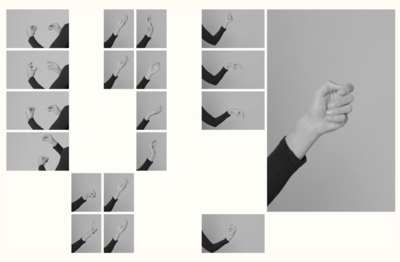[028]
A Guide To Softer Ware
Collaboration
experimental
A Guide To Softer Ware is a collaborative exploration of contemporary and not-so-contemporary languages of instruction in the context of “womanhood”, calling out their binary notions of gender designation as a social construct. Through analysing their own behavior as socialised women, and simultaneously analysing guides by women addressing other women about how to be a woman, Charlotte Rohde and Vera van de Seyp expose the idea of the manual as a (self-)imposed directive, trapped between the imperative to be unconditionally affirmed and the need to be in charge of one’s own narrative.
The format of the manual is used here as a rhetorical construct that explores how the social roles of women have been impacted by the rise of new technologies from the second half of the 20th century until now. With their shared background ranging from (type-)design to creative coding, Charlotte Rohde and Vera van de Seyp (quite literally) deconstruct and reprogramme these languages of instruction: From the wording used in 1960s technical manuals for sewing machines, knitting machines and various domestic appliances addressing women as a new target group to Memes and YouTube tutorials as a phenomenon representing the contemporary internet culture of self-optimization.
With their Guide To Softer Ware the two artists reflect on the supposed need for guidance and the forms this guidance has historically taken and still takes. The exhibition at soft power presents new works by the two artists that may function as a manual for the spectators and simultaneously as type specimens. The use of tools and typography, soap and metal, software and code (and ultimately, the use of the body itself), invites us to question the „softness“ historically/conventionally/subconsciously assigned to certain materials and spaces, to gender and its construction.
18.11.25
[076]
Coded Gestures
Collaboration
speculative

Coded Gestures, Sanne van den Elzen
In form of a short research paper, Maughan explores the evolution and potential of hand gestures in human-computer interaction, particularly in the context of emerging spatial computing technologies. The paper reflects on the historical significance of hand representations, such as ancient cave paintings, and examines how our hands have co-evolved with tool use over millennia. It critiques the current design of hand gestures in technology, like Apple's double tap, as mere extensions of existing interactions, and advocates for reimagining hand-based interactions to fully harness the capabilities of spatial computing.
Maughan lays out how gestures serve as both a bridge and a blueprint for future embodied technologies, shaping how we interact beyond screens and devices. As spatial computing evolves, gestures could inspire more fluid, intuitive interfaces that dissolve the boundaries between digital and physical spaces. Their design must embrace cultural diversity, ergonomic fluidity, and emotional expressivity to create meaningful, adaptive interactions. By moving beyond prescriptive, pre-defined gestures, future formats of embodied technology can foster a more symbiotic relationship between humans and machines—one where interaction feels as instinctive as movement itself.
“Annie Murphy Paul notes how gestures help us pin down vague thoughts, offering a “proprioceptive hook” that distributes cognitive load and assists memory. Gestures accompany everyday speech. They replace it when we lack a shared language, or when speech becomes
inaudible or dangerous.”
18.11.25
